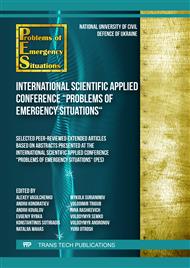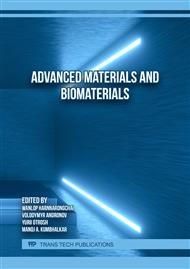[1]
V. Kuprikov, V. Pilipenko, A. Soznik, Description of deuteron-nucleus scattering in terms of a microscopic optical potential based on Skyrme forces, Physics of Atomic Nuclei, 75 (7) (2012) 832-844.
DOI: 10.1134/s1063778812040084
Google Scholar
[2]
O. Popov, A. Iatsyshyn, D. Sokolov, M. Dement, I. Neklonskyi, A.Yelizarov, Terms and conditions Privacy policy Application of virtual and augmented reality at nuclear power plants Studies in Systems, Decision and Control, 346 (2021) 243-260.
DOI: 10.1007/978-3-030-69189-9_14
Google Scholar
[3]
H. Tulskyi, L. Liashok, H. Shevchenko, A. Vasilchenko, O. Stelmakh, Synthesis of functional nanocomposites based on aluminum oxide, Functional Materials, 26 (4) (2019) 718-722.
Google Scholar
[4]
V. Pilipenko, V. Kuprikov, A. Soznik, Skyrme interaction and elastic nucleon-nucleus scattering in the optical model, Physical Review C - Nuclear Physics, 81 (4) (2010) 044614.
DOI: 10.1103/physrevc.81.044614
Google Scholar
[5]
O. Nekora, V. Slovynsky, S. Pozdieiev, The research of bearing capacity of reinforced concrete beam with use combined experimental-computational method, MATEC Web of Conferences, 116 (2017) 02024.
DOI: 10.1051/matecconf/201711602024
Google Scholar
[6]
M. Surianinov, V. Andronov, Yu. Otrosh, T. Makovkina, S. Vasiukov, Concrete and fiber concrete impact strength, Materials Science Forum, 1006 (2020) 101-106.
DOI: 10.4028/www.scientific.net/msf.1006.101
Google Scholar
[7]
A. Kovalov, Yu. Otrosh, S. Vedula, O. Danilin, T. Kovalevska, Parameters of fire-retardant coatings of steel constructions under the influence of climatic factors, Naukovyi Visnyk Natsionalnoho Hirnychoho Universytetu, 3 (2019) 46-53.
DOI: 10.29202/nvngu/2019-3/9
Google Scholar
[8]
V. Sadkovyi, V. Andronov, O. Semkiv, A. Kovalov, E. Rybka, Yu. Otrosh, M. Udianskyi, V. Koloskov, A. Danilin, A. Kovalov, Fire resistance of reinforced concrete and steel structures, Kharkiv: РС Тechnology center, 180 (2021) 1-166.
DOI: 10.15587/978-617-7319-43-5
Google Scholar
[9]
Yu. Otrosh, O. Semkiv, E. Rybka, A. Kovalov, About need of calculations for the steel framework building in temperature influences conditions, IOP Conference Series: Materials Science and Engineering, 708 (1) 012065 (2019).
DOI: 10.1088/1757-899x/708/1/012065
Google Scholar
[10]
Y. Danchenko, V. Andronov, E. Barabash, T. Obigenko, E. Rybka, R. Meleshchenko, A. Romin, Research of the intramolecular interactions and structure in epoxyamine composites with dispersed oxides, Eastern-European Journal of Enterprise Technologies, 6 (12–90) (2017) 4-12.
DOI: 10.15587/1729-4061.2017.118565
Google Scholar
[11]
S. Shchukarev, O termycheskoi ustoichyvosty okyslov marhantsa y zheleza, Uch. zap. LHU: Seryia khymycheskaia, 7 (79) (1945) 197-203.
Google Scholar
[12]
A. Morachevskyi, Y. Sladkov, Thermodynamic calculations in metallurgy, M.: Metallurhyia, (1985).
Google Scholar
[13]
V. Babushkyn, H. Matveev, O. Mchedlov-Petrosian, Termodynamyka sylykatov, M.: Stroiyzdat, (1986).
Google Scholar
[14]
V. Hlushko, Thermodynamic constants of substances, M.: Yzd. AN USSR, 9 (1979).
Google Scholar
[15]
G. Shabanova, S. Bykanov, The structure of the BaO-Al2O3-Fe2O3 system, Refractories and technical ceramics, 7- 8 (2002) 21-24.
Google Scholar
[16]
N. Landyia, Calculation of high-temperature heat capacity of solid organic substances by standard entropy, Tbylysy: Yzd. AN USSR, (1962).
Google Scholar
[17]
R. Hrebenshchykov, Thermal studies of barium silicates and aluminates in the BaO-Al2O3-SiO2 system, Silicates and oxides in high temperature chemistry, M.: Yzd. AN USSR, (1963) 290-302.
Google Scholar
[18]
G. Shabanova, O. Mirgorod, A. Ruban, V. Shvedun, Experiment Planning for Prospective Use of Barium-Containing Alumina Cement for Refractory Concrete Making, In Materials Science Forum. Trans Tech Publications Ltd, 1038 (2021) 330-335.
DOI: 10.4028/www.scientific.net/msf.1038.330
Google Scholar
[19]
O. Borisenko, S. Logvinkov, G. Shabanova, O. Myrgorod, Thermodynamics of solid-phase exchange reactions limiting the subsolidus structure of the system MgO-Al2O3-FeO-TiO2, In Materials Science Forum. Trans Tech Publications Ltd, 1038 (2021) 177-184.
DOI: 10.4028/www.scientific.net/msf.1038.177
Google Scholar
[20]
P. Appendino, Sistema ossido di barioallumina, Ceramurgia, 2(1) (1972) 103-105.
Google Scholar
[21]
P. Appendino, Ricerche sul sistema silice – alumina-ossido di barrio, Rev. Haut. Temper. Refract, 9 (3) (1972) 297-299.
Google Scholar
[22]
P. Appendino, Recerche sulla zona piu basica del sistema ossido di barioallumina, Annali de chimia, Ital., 61(12) (1971) 822-830.
Google Scholar
[23]
F. Stryhunov, V. Alekseev, Investigation of the reaction in a system, containing BaS, SiO2, Al2O3, Fe2O3, H2O, Journal of Applied Chemistry, 158 (11) (1975) 2445-2447.
Google Scholar



